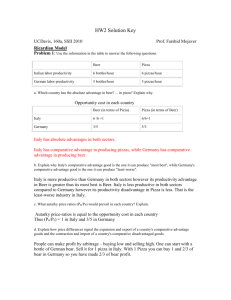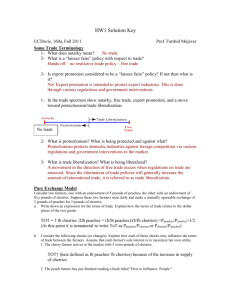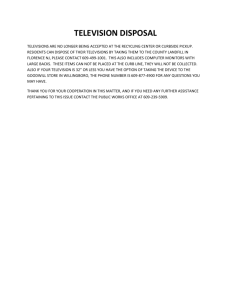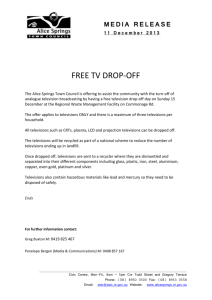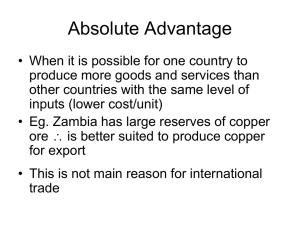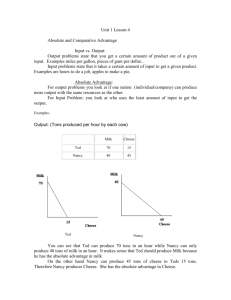HW2 Solution Key
advertisement
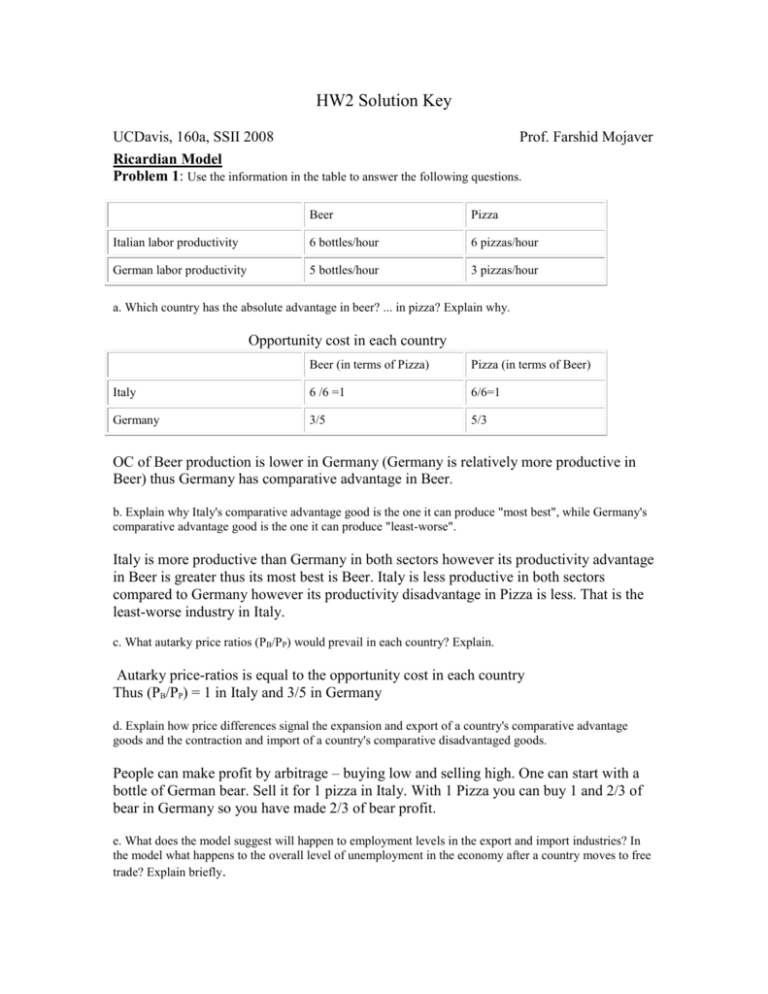
HW2 Solution Key UCDavis, 160a, SSII 2008 Prof. Farshid Mojaver Ricardian Model Problem 1: Use the information in the table to answer the following questions. Beer Pizza Italian labor productivity 6 bottles/hour 6 pizzas/hour German labor productivity 5 bottles/hour 3 pizzas/hour a. Which country has the absolute advantage in beer? ... in pizza? Explain why. Opportunity cost in each country Beer (in terms of Pizza) Pizza (in terms of Beer) Italy 6 /6 =1 6/6=1 Germany 3/5 5/3 OC of Beer production is lower in Germany (Germany is relatively more productive in Beer) thus Germany has comparative advantage in Beer. b. Explain why Italy's comparative advantage good is the one it can produce "most best", while Germany's comparative advantage good is the one it can produce "least-worse". Italy is more productive than Germany in both sectors however its productivity advantage in Beer is greater thus its most best is Beer. Italy is less productive in both sectors compared to Germany however its productivity disadvantage in Pizza is less. That is the least-worse industry in Italy. c. What autarky price ratios (PB/PP) would prevail in each country? Explain. Autarky price-ratios is equal to the opportunity cost in each country Thus (PB/PP) = 1 in Italy and 3/5 in Germany d. Explain how price differences signal the expansion and export of a country's comparative advantage goods and the contraction and import of a country's comparative disadvantaged goods. People can make profit by arbitrage – buying low and selling high. One can start with a bottle of German bear. Sell it for 1 pizza in Italy. With 1 Pizza you can buy 1 and 2/3 of bear in Germany so you have made 2/3 of bear profit. e. What does the model suggest will happen to employment levels in the export and import industries? In the model what happens to the overall level of unemployment in the economy after a country moves to free trade? Explain briefly. In Germany employment in Beer (its export sector) goes up, and it goes down in Pizza. The opposite happens in Italy. That is employment in Pizza (its export sector) goes up and in Beer goes down. Assuming free and costless movement of labor there will be no unemployment. Problem 2 a. Definition 1 The opportunity cost of producing X is the amount of Y forgone to produce one extra unit of X. • Opportunity Cost of producing good X in the Home country: aLX/aLY = 1/(1/2) = 2 units of Y . • Opportunity Cost of producing good X in the Foreign country: aLX*/aLY* = (1/4)/1=1/4 units of Y . b. • Relative price of good X at Home in autarky: In perfect competition wages are set to price * marginal productivity of labor, thus wages in the X and Y industries are set to X = PX/aLX Y = PY/aLY As described in lecture, this implies that in a diversified perfectly competitive equilibrium, we must have that PX/aLX = PY/aLY PX/PY = aLX/aLY PX/PY =1/(1/2) =2 • Similarly for Foreign: PX*/PY* = (1/4)/1 = 1/4 c. In order to be able draw the PPF we need to know how the available resources can be distributed over the production of X and Y. This is given by L = QX . aLX + QY . aLY rewriting this expression, we get QY = L/ aLX - (aLX /aLY)QX, which is a linear equation with Y y-intercept L/aLY and slope aLX/aLY. So for Home QY = L/aLY - (aLX /aLY)QX, QY = 1000/(1/2) – (1/2)QX QY = 2000 – 2QX and for Foreign QY* = L*/ aLX* - (aLX */aLY*)QX*, QY* = 1000/1 – (1/4)/1QX* QY* = 1000 – 1/4QX* PPF’s Under Autarky Problem 3 Labor Opportunity Costs Labor Requirement Endowment aLW aLC PW/PC PC/PW Wonderland 10 5 2 1/2 40m ROW 6 2 3 1/3 30m a. ROW has absolute advantage on producing both wine and cheese because its labor requirements are lower. b. Comparative advantage means lower opportunity costs. Therefore, wonderland has comparative advantage in producing wine and ROW has comparative advantage in producing cheese. c. Wonderland: 10QW + 5QC = 40; ROW: 6 QW + 2QC = 30 d. 15 Cheese P Cheese 8 C 10 5 C A 4 6 A P 2 4 Wine Wonderland 2 3 5 ROW Wine e. When the world price ratio is .4 bottle wine per pound of cheese, PC/PW = .4 and therefore, PW/PC = 2.5. In this case, the world price ratio is between these two country’s opportunity costs, therefore, Wonderland will specialize in producing wine (4m bottles of wine) and ROW will specialize in producing cheese (15m pounds of cheese). Problem 4 Assume that Home and Foreign produce two goods, televisions and cars, and use the following information to answer the questions. a. What is the marginal product of labor for televisions and cars in the Home country? What is the no-trade relative price of televisions at Home? Answer: MPLC =3, MPLTV =2, and PTV/ P C = MPL C / MPLTV =3/2 b. What is the marginal product of labor for televisions and cars in Foreign? What is the no-trade relative price of televisions in Foreign? Answer: MPL*C =3, MPL*TV =2, and P*TV/ P* C = MPL* C / MPL*TV =1/2 c. Suppose the world relative price of televisions in the trade equilibrium is PTV/ PC =1. Which good will each country export? Briefly explain why. Answer: Home will export cars and Foreign will export televisions because Home has a comparative advantage in cars whereas Foreign has a comparative advantage in televisions. d. In the trade equilibrium, what is the real wage at Home in terms of cars and in terms of televisions? How do these values compare with the real wage in terms of either good in the no-trade equilibrium? Answer: Workers at Home are paid in terms of cars because Home exports cars. Home is better off with trade because its real wage in terms of televisions has increased. e. In the trade equilibrium, what is the real wage in Foreign in terms of televisions and in terms of cars? How do these values compare with the real wage in terms of either good in the no-trade equilibrium? Answer: Foreign workers are paid in terms of televisions because Foreign exports televisions. f. In the trade equilibrium, do Foreign workers earn more or less than those at Home, measured in terms of their ability to purchase goods? Explain why. Answer: Foreign workers earn less than workers at Home in terms of cars because Home has an absolute advantage in the production of cars. Home workers also earn more than Foreign workers in terms of televisions. Problem 5 a. Suppose that the number of workers doubles in Home. What happens to the Home PPF and what happens to the no-trade relative price of wheat? Answer: With the doubling of the number of workers in Home, it can now produce 200 = 4 x 50 bushels of wheat if it concentrates all resources in the production of wheat or it could product 100 = 2 x 50 yards of cloth by devoting all resources to the production of cloth. The PPF shifts out for both wheat and cloth. The no-trade relative price of wheat remains the same because both MPLW and MPLC are unchanged. b. Instead of doubling the number of workers in Home, suppose that there is technological progress in the wheat industry, so that Home can produce more wheat with the same amount of labor. What happens to the Home PPF, and what happens to the relative price of wheat? Describe what would happen if a similar change occurred in the cloth industry. Answer: Because the technological progress is only in the wheat industry, Home’s production of cloth remains the same if it devotes all of its resources to producing cloth. If instead Home produces only wheat, it is able to produce more wheat using the same amount of labor. Home’s PPF shifts out in the direction of wheat production. Recall that the relative price of wheat is given by PW / PC =MPLC / MPLW. With the technological progress in wheat, the marginal product of labor in the wheat production increases. Thus, the relative price of wheat decreases. If instead, the technological progress is in the cloth industry, we would have the opposite results. Home’s PPF would shift out in the direction of cloth production and the relative price of wheat would increase. Problem 6 Consider the graph below. A is the autarky production and consumption point for this economy. Suppose international terms of trade are represented by line P*. Show gains from trade if the country decides to join international trade without changing its production point. Qw B C IFT A P* IAut IC QC Question 7 Make an argument to show that a domestic firm may lose out in international competition even if it is the most productive producer in the world. A domestic firm that has the highest productivity in the world may lose out in international trade because there might be firms with even higher productivity in that country that drive the average wages higher (i.e, US might have the most productive apparel industry in the world but even higher productivity in wheat production drives the wages high so that it is not cost effective produce apparel in US). Question 8 Read the following excerpt from Adam Smith on division of labor and labor productivity to answer the subsequent questions http://william-king.www.drexel.edu/top/Prin/txt/Intro/Eco111g.html 1- When we speak of specialization in the Ricardian model and increased national and international productivity do we have the Smithian model in mind? With Ricardian specialization we mean shifting resources to sectors with comparative advantage so we produce more with the same level of productivity. In the Smithian model specialization increases productivity so there is an additional source of gain from trade in his that model. 2- What does the Smithian division of labor imply on the productivity of larger economies? Larger economies with larger demand for everything imply more division of labor higher levels of specialization and higher productivity. Thus larger economies are more productive according to the Smithan model while in the Recardian model country size does not affect productivity. 3- What is the source of gains from trade and increased productivity in the Ricardian model? Allocation efficiency 4- Consider a two good economy: grain and computer. They are both produced with labor only but grain is subject to constant return to scale technology while computer production is subject to increasing return to scale technology. Draw the Production Possibility Frontier for this economy.
